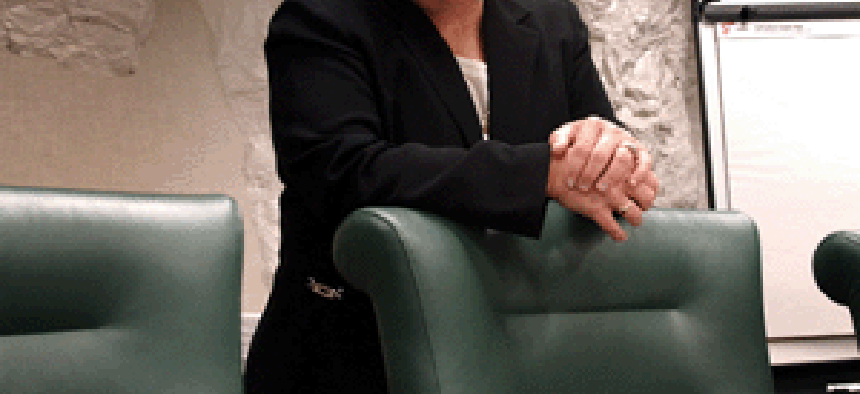Survival Guide: Perspectives from the field

Kathy Dillaman faced a monumental task in February when she took on the job of clearing the Defense Department's backlog of security clearance investigations for federal employees and contractors.
Kathy Dillaman faced a monumental task in February when she took on the job of clearing the Defense Department's backlog of security clearance investigations for federal employees and contractors. To surmount the task, she first consolidated OPM's and DOD's clearance investigations.The total investigations backlog, including the Defense Department's, stood at 185,000. Today, the number of investigations still incomplete after 120 days has been cut to about 110,000. Dillaman's goal, set by intelligence reform legislation, is by the end of 2006 to regularly complete 80 percent of all investigations within 90 days.Dillaman, whose official title is deputy associate director of investigations for the Center for Federal Investigative Services, is tackling this project from an underground office in a converted limestone-mining tunnel in Boyers, Pa. She spoke with Staff Writer Alice Lipowicz about her assignment. Do you have a sense of the frustration over the slow pace of processing these security clearances? Absolutely. I have to clear my own employees, and I get no special service. If you cannot clear people, you cannot get the talent you need. How are you doing on reducing the backlog? At any given time, we have about 400,000 pending investigations. We do investigations not just for clearances, but also to determine suitability for positions of public trust and for regulatory purposes.For security clearances, we have 54,000 pending top-secret investigations. Of those, 30,000 are more than 120 days old. We have 172,000 pending secret and confidential clearances in process, and of those, 80,000 are more than 120 days old.We have 110,000 pending investigations that are more than 120 days old. That number has come down from 185,000 in February and 169,000 in July. We are mandated that by the end of 2006, 80 percent of our investigations must be closed within 90 days. We believe we will meet that date. Right now, we have six companies under contract, with about 6,000 contract employees and 2,000 federal employees. What is your greatest challenge in reducing the backlog? It's a balancing act to make sure I have the resources available for an unpredictable workload. I'm working with the federal agencies to get good projections. In addition, we rely on the cooperation of citizens, record systems in the states and law enforcement agencies. How do you use IT systems? The 50 states have 50 different ways of managing their records. One of the main things we did was to implement online access for electronic exchange with the FBI's Integrated Automated Fingerprint Identification System. It takes us five hours to get a digital fingerprint check now. That is spectacular. It used to take 60 to 120 days.I don't have an IT background, but I've been comfortable with automation since the 1980s. When you're handling 1.4 million requests a year, you need rigid tracking and control systems. We're minimizing paper handling.Not all the state and local agencies are at the same level: Some are sophisticated and some are not. You'll always have that small post office that insists on using paper. Why do you believe you'll eliminate the investigations backlog by the end of 2006? You have to keep in mind that there may be other delays. The clearance-requesting agency needs to submit the paperwork to me. When I'm finished, it goes back to the adjudicating agency and there can be delays then.All the pieces are in place. It could get derailed if there is another 9/11 incident with an unprecedented need for clearances. But now we've got the people in place to reduce that huge [backlog] number. Has there been any impact from Hurricane Katrina? There has been no increase in demand. But it could complicate the work for people whose records are from that region. Please tell me about your unusual office. I've been working here since 1977. I started as a clerk and worked my way up. This place has history: My grandfather used to work in these mines. It's about 250 feet underground. From the surface, you would not see anything. There is nothing above ground except the parking lot. Is there an elevator? No, it's an inclined walkway. There is no humidity. It's very secure. And no windows ? no distractions. In 1977, when we came here, it was because it was cost-competitive, secure and there was a high-quality workforce available. Western Pennsylvania had been hard hit economically. Also, paper does not deteriorate in this climate. How do you like your office? In my office, I have three walls that are dry wall, and one that is a rock wall. It looks just like the miners left it, with drill marks.I'm picturing black rock. No, it's painted, partly to seal in moisture. The walls are all painted a cream color. It has a nice feel to it.

WT:
Dillaman:
WT:
Dillaman:
WT:
Dillaman:
WT:
Dillaman:
WT:
Dillaman:
WT:
Dillaman:
WT:
Dillaman:
WT:
Dillaman:
WT:
Dillaman:
WT:
Dillaman:

Kathy Dillaman
Jeff Swensen
WT:
Dillaman:
WT:
Dillaman:
WT:
Dillaman:
WT:
Dillaman:
WT:
Dillaman:
WT:
Dillaman:
WT:
Dillaman:
WT:
Dillaman:
WT:
Dillaman:
WT:
Dillaman:
NEXT STORY: Homeland watch

